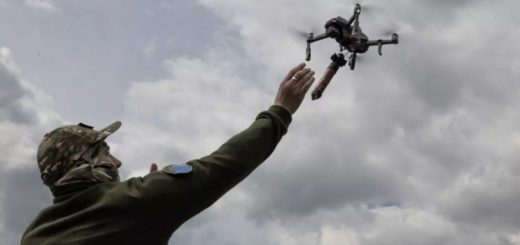Exclusive: U.S. General Atomics MQ-9B Drone Gains Deep Strike And Intel Capability With PELE Drone Integration

{loadposition bannertop}
{loadposition sidebarpub}
According to information published by General Atomics Aeronautical Systems Inc. (GA-ASI) on June 15, 2025, the company has officially introduced its latest innovation in unmanned aviation technology: the Precision Exportable Launched Effect (PELE). Designed to enhance the operational envelope of the MQ-9B SkyGuardian® significantly, PELE is a small, propeller-driven unmanned aircraft with multi-mission capabilities intended to operate in high-risk environments as a forward sensor and loitering system.Follow Army Recognition on Google News at this link
Artist rendering shows GA-ASI PELE loitering drone deploying from MQ-9B SkyGuardian for strike and Intelligence roles. (Picture source: GA-ASI)
The PELE drone, whose name draws inspiration from the Hawaiian goddess of powerful natural forces, is engineered for attrition tolerance and semi-autonomous operations. Measuring 9 feet in length with an 11-foot wingspan and powered by a 16-horsepower engine, PELE offers a maximum endurance of 7 hours and an operational range of up to 500 nautical miles. Its design enables deployment from both air and ground platforms, giving forces increased flexibility in contested environments and denied-access zones.
One of PELE’s standout features is its integration potential with the MQ-9B SkyGuardian®, a flagship MALE (medium-altitude, long-endurance) UAV that serves as the cornerstone of multi-domain operations for several U.S. allies. When deployed from the MQ-9B, PELE transforms the unmanned mothership from a persistent ISR asset into a multi-tiered, force-multiplying combat platform. This integration allows the MQ-9B to release several PELEs mid-mission, extending its reach and survivability deep into enemy territory while remaining outside the effective range of adversary defenses.
In a typical scenario, MQ-9B could approach a contested boundary from international airspace and release PELEs to probe hostile zones, execute real-time surveillance, detect and geo-locate surface-to-air missile systems, or conduct electronic warfare tasks. PELE’s onboard EO/IR sensors allow it to transmit full-motion video back to command elements, while its internal payload bay provides the versatility to carry jammers, decoys, or kinetic micro-munitions. This gives commanders a scalable response option—from intelligence collection to electronic suppression or direct engagement—without exposing the more strategic MQ-9B asset to risk.
PELE also offers a platform for experimentation in swarming tactics and manned-unmanned teaming (MUM-T) concepts. Multiple PELEs could operate in coordinated formations to saturate and confuse enemy radar, provide persistent coverage of a target area, or deliver effects in a synchronized strike. This kind of capability is particularly valuable in scenarios involving anti-access/area-denial (A2/AD) threats, where penetrating ISR or offensive capability must be accomplished without escalating the conflict or risking high-value assets.
By developing PELE as a modular and cost-effective loitering drone with high survivability in hostile airspace, GA-ASI is reinforcing its role as a leader in distributed unmanned operations. PELE is not only a sensor extender but a tactical game-changer that turns the MQ-9B into a launching platform for multidomain operations, pushing the boundaries of what unmanned systems can achieve in modern warfare.

{loadposition bannertop}
{loadposition sidebarpub}
According to information published by General Atomics Aeronautical Systems Inc. (GA-ASI) on June 15, 2025, the company has officially introduced its latest innovation in unmanned aviation technology: the Precision Exportable Launched Effect (PELE). Designed to enhance the operational envelope of the MQ-9B SkyGuardian® significantly, PELE is a small, propeller-driven unmanned aircraft with multi-mission capabilities intended to operate in high-risk environments as a forward sensor and loitering system.
Follow Army Recognition on Google News at this link
Artist rendering shows GA-ASI PELE loitering drone deploying from MQ-9B SkyGuardian for strike and Intelligence roles. (Picture source: GA-ASI)
The PELE drone, whose name draws inspiration from the Hawaiian goddess of powerful natural forces, is engineered for attrition tolerance and semi-autonomous operations. Measuring 9 feet in length with an 11-foot wingspan and powered by a 16-horsepower engine, PELE offers a maximum endurance of 7 hours and an operational range of up to 500 nautical miles. Its design enables deployment from both air and ground platforms, giving forces increased flexibility in contested environments and denied-access zones.
One of PELE’s standout features is its integration potential with the MQ-9B SkyGuardian®, a flagship MALE (medium-altitude, long-endurance) UAV that serves as the cornerstone of multi-domain operations for several U.S. allies. When deployed from the MQ-9B, PELE transforms the unmanned mothership from a persistent ISR asset into a multi-tiered, force-multiplying combat platform. This integration allows the MQ-9B to release several PELEs mid-mission, extending its reach and survivability deep into enemy territory while remaining outside the effective range of adversary defenses.
In a typical scenario, MQ-9B could approach a contested boundary from international airspace and release PELEs to probe hostile zones, execute real-time surveillance, detect and geo-locate surface-to-air missile systems, or conduct electronic warfare tasks. PELE’s onboard EO/IR sensors allow it to transmit full-motion video back to command elements, while its internal payload bay provides the versatility to carry jammers, decoys, or kinetic micro-munitions. This gives commanders a scalable response option—from intelligence collection to electronic suppression or direct engagement—without exposing the more strategic MQ-9B asset to risk.
PELE also offers a platform for experimentation in swarming tactics and manned-unmanned teaming (MUM-T) concepts. Multiple PELEs could operate in coordinated formations to saturate and confuse enemy radar, provide persistent coverage of a target area, or deliver effects in a synchronized strike. This kind of capability is particularly valuable in scenarios involving anti-access/area-denial (A2/AD) threats, where penetrating ISR or offensive capability must be accomplished without escalating the conflict or risking high-value assets.
By developing PELE as a modular and cost-effective loitering drone with high survivability in hostile airspace, GA-ASI is reinforcing its role as a leader in distributed unmanned operations. PELE is not only a sensor extender but a tactical game-changer that turns the MQ-9B into a launching platform for multidomain operations, pushing the boundaries of what unmanned systems can achieve in modern warfare.





